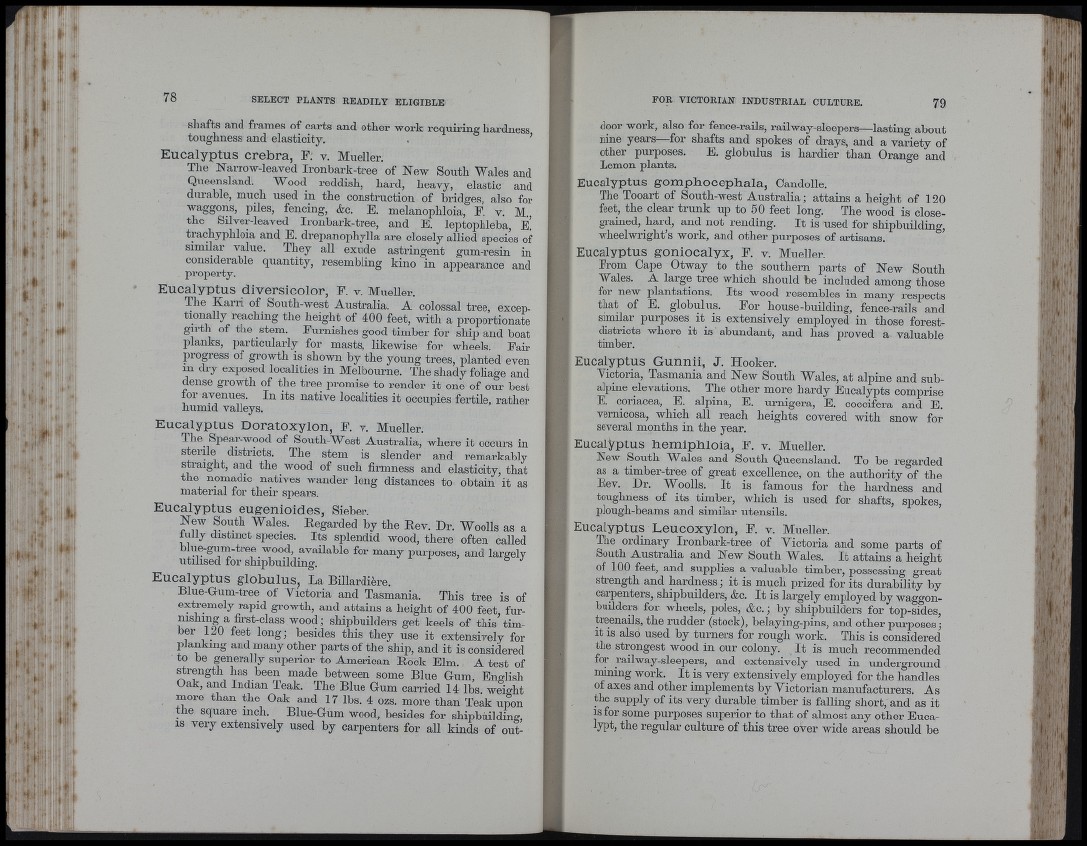
.Mi
■H» ”
J . , ,,
r :
ii':
78 SELECT PLANTS READILY ELIGIBLE
shafts and frames of carts and other work requiring hardness
toughness and elasticity. . ^
Eucalyptus crebra, F. v. Mueller.
The Narrow-leaved Ironbark-tree of New South Wales and
Queensland. Wood reddish, hard, heavy, elastic and
durable, much used in the construction of bridges, also for
waggons, piles, fencing, &c. E. melanophloia, F. v. M.
tbe Silver-leaved Ironbark-tree, and E. leptopbleba, e !
tracbypliloia and E. drepanophylla are closely allied species of
similar value. They all exude astringent gum-resin in
considerable quantity, resembling kino in appearance and
property.
Eucalyptus diversicolor, F. v. Mueller.
The Karri of South-west Australia. A colossal tree, exceptionally
reaching the height of 400 feet, with a proportionate
girth of the stem. Furnishes good timber for ship and boat
planks, particularly for masts, likewise for wheels. Fair
progress of growth is shown by tbe young trees, planted even
in dry exposed localities in Melbourne. The shady foliage and
dense growth of the tree promise to render it one of our best
for avenues. In its native localities it occiiiiies fertile, rather
humid valleys.
Eucalyptus Doratoxylon, E. v. Mueller.
The Spear-wood of South-West Australia, where it occurs in
sterile districts. The stem is slender and remarkably
straight, and the wood of such firmness and elasticity, that
the nomadic natives wander long distances to obtain it as
material for their spears.
Eucalyptus eugenioides, Sieber.
New South Wales. Regarded by the Rev. Dr. Woolls as a
tully distinct species. Its splendid wood, there often called
available for many purposes, and largely
utihsed for shipbuilding.
Eucalyptus globulus. La Biliardière.
Blue-Gum-tree of Victoria and Tasmania. This tree is of
extremely rapid growth, and attains a height of 400 feet furnishing
a first-class wood; shipbuilders get keels of this’ timber
120 feet long; besides this they use it extensively for
planking and many other parts of tlie ship, and it is considered
to be generally superior to American Rock Elm. A test of
rtrength has been made between some Blue Gum, Eimlish
Oak, and Indian Teak. The Blue Gum carried 14 lbs. weio-ht
more than the Oak and 17 lbs. 4 ozs. more than Teak upon
the square mch. Blue-Gum wood, besides for sbipbùilding,
IS very extensively used by carpenters for all kinds of out-
FOR VICTORIAN INDUSTRIAL CULTURE. 79
door work, also for fence-rails, railway-sleepers—lasting about
nine years for shafts and spokes of drays, and a variety of
other purposes. E. globulus is hardier than Orange and
Lemon plants.
E u ca lyp tu s g om p h o c e p h a la , Candolle.
The Tooart of South-west Australia; attains a height of 120
feet, the clear trunk up to 60 feet long. The wood is close-
grained, hard, and not rending. I t is used for shipbuildmg,
wheelwright’s work, and other purposes of artisans.
E u c a lyp tu s g o n io c a ly x , E. v. Mueller.
From Cape Otway to the southern parts of New South
Wales. A large tree which should be included among those
for new plantations. Its wood resembles in many respects
that of E. globulus. Eor house-building, fence-rails and
similar purposes it_ is extensively employed in those forest-
districts where it is abundant, and has proved a valuable
timber.
Eucalyptus Gunnii, J. Hooker.
Victoria, Tasmania and New South Wales, at alpine and sub-
alpine elevations. The other more hardy Encalypts comprise
E. coriacea, E. alpina, E. urnigera, E. coccifera and E.
vernicosa, which all reach heights covered with snow for
several months in the year.
Eucalyptus hemiphloia, F. v. Mueller.
New South Wales and South Queensland. To be regarded
as a timber-tree of great excellence, on the authority of the
Rev. Dr. Woolls. I t is famous for the hardness and
toughness of its timber, which is used for shafts, spokes,
plough-beams and similar utensils. ’
Eucalyptus Leucoxylon, E. v. Mueller.
The ordinary Ironbark-tree of Victoria and some parts of
South Australia and New South Wales. I t attains a height
of 100 feet, and supplies a valuable timber, possessing great
streng-tb and hardness; it is much prized for its durability by
carpenters, sliipbuilders, &c. I t is largely employed by waggon-
builders for wheels, poles, &c. ; by shipbuilders for top-sides,
treenails, tbe rudder (stock), belaying-pins, and other purposes;
it is also used by turners for rough work. This is considered
the strongest wood in our colony. I t is much recommended
for railway-sleepers, and extensively used in underground
mining work. I t is very extensively employed for the handles
of axes and other implements by Victorian manufacturers. As
the supply of its very durable timber is falling short, and as it
IS for some purposes superior to that of almost any other Euca-
lypt, the regular culture of this tree over wide areas should be
( I
I M ii.i
.t i
■ 1
’ I '